Former St Kilda defender Matt Maguire reveals the devastating king hit that left him with blood spots on his brain
Former St Kilda hard man Matt ‘Goose’ Maguire says a cowardly punch in during a match left him with blood spots on his brain blurred vision and dizzy spells. He’s concerned about the impact of multiple concussions he suffered in his career.
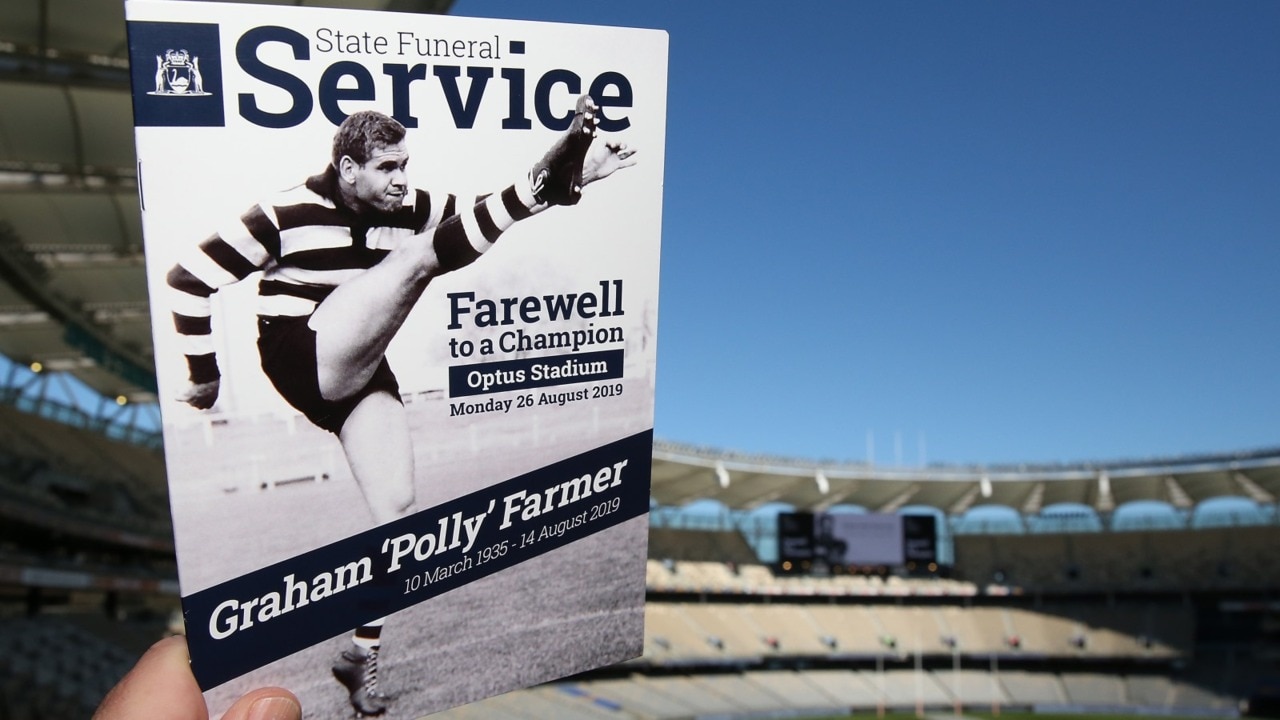
AFL News
Don't miss out on the headlines from AFL News. Followed categories will be added to My News.
Matt Maguire wonders whether he would want his children to play like he did.
At St Kilda and Brisbane, Maguire carved a reputation as one of the AFL’s most courageous defenders.
He was the Jonathan Brown of the back line.
But he also paid a price and retired after his seventh concussion in 2015.
He says “my career ended after a gutless king hit” when a NEAFL opponent struck him from behind in an incident which landed his man a two-match suspension.
Scans showed blood spots on Maguire’s brain and early on he suffered blurred vision and dizzy spells.
Watch every match of every round of the 2020 Toyota AFL Premiership Season LIVE & On-Demand with KAYO. New to Kayo? Get your 14-day free trial & start streaming instantly >
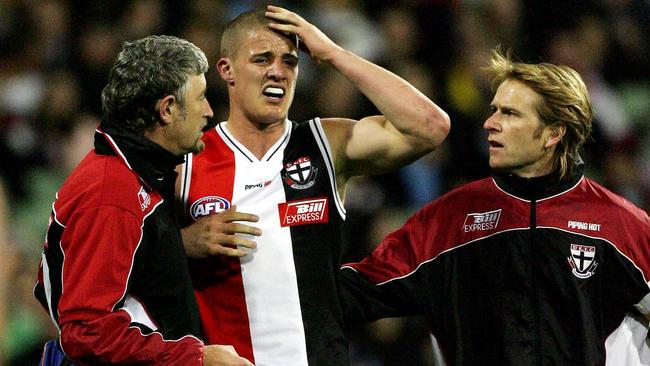
Subsequently, Maguire has significantly reduced his alcohol consumption.
He drinks light beer, eats well and gets plenty of sleep to feel well.
But as a parent, Maguire now wonders how brave do you want your kids to be on the footy field, or any sporting ground?
Especially when courage is the most-respected commodity.
“I was brought up to never take your eyes off the ball and if you do you are a coward,” Maguire said.
“If you take a few short steps you hear over the fence at the footy, “you heard footsteps”.
“And the way you play football was how you were perceived as a person.
“If you played it in the right manner you were perceived as tough, courageous, brave.
“And if you are not prepared to do that then your place in the side is in jeopardy the following week.
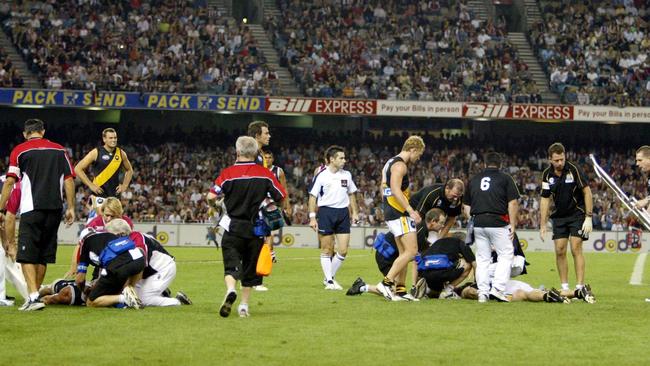
MORE ON MAGUIRE:
Brisbane’s Matt Maguire forced to retire after another concussion
Retired players Sam Blease and Matt Maguire finally win concussion compensation

“I have had the conversation with myself now, what would I expect of my son playing football?
“How would I view him taking a short step?
“Is it the most important thing to be the most courageous on the field?
“Maybe it’s not. I’m not sure.”
Maguire said the head knocks he suffered and the links to CTE played on his mind.
“I’ve got a young family. I want to make sure I’m going to be there to see my grandkids grow up,” he said.
Maguire, 35, said he had been “knocked out” in a game but kept playing.
“But that’s because you had passed a concussion test,” he said.
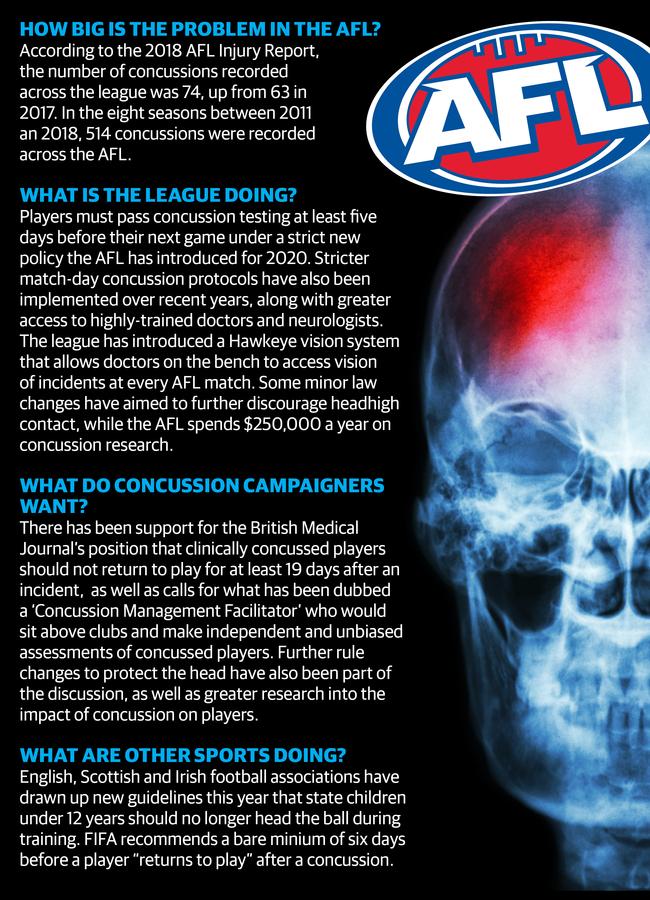
The 170-gamer said the league had to take an incredibly strong stance against king hits on the field, and was in favour of reducing the damage from bumps where players are blindsided.
But he said some contact was unavoidable in Australian rules.
“There are times when you probably put yourself in positions you shouldn’t be,” he said.
“But sometimes it is just general play, the cut and thrust of football.
“You were open to the risks you are aware of and now there is more awareness, players have got to evaluate their own risk. But I never went into a game feeling like my head wasn’t right.”
Maguire’s St Kilda teammate Justin Koschitzke suffered horribly from head knocks on the field.
Maguire said players had to be protected from opponents coming in from blind spots.
“Maybe you can only bump from one metre away, or arm’s length,” he said.
“Limit the ability for someone to really get a run up and blindside someone. You don’t want to see people get knocked out like Kosi was.”
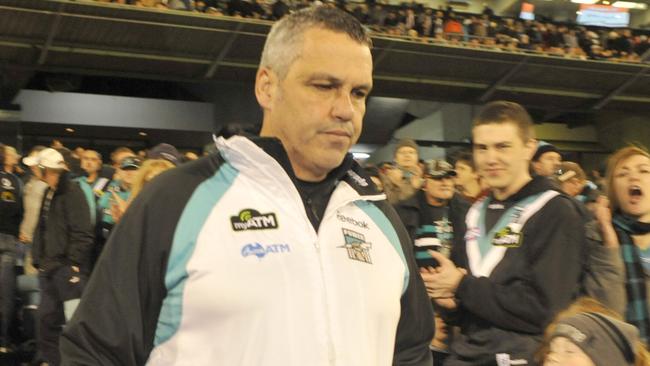
CHOCO: IT’S TIME TO BAN THE BUMP
—Jon Ralph and Rebecca Williams
Premiership coach Mark Williams has called for the AFL to ban the bump.
Port Adelaide legend William was the man who in 2009 called on the AFL to crack down on headhigh hits, which resulted in landmark tribunal penalties and a massive reduction in dangerous blows.
Williams told the Herald Sun yesterday he believed the next step was getting rid of bumps on unsuspecting players, considering how dangerous subconcussions — head knocks that don’t cause concussion symptoms — and concussions were.
“I don’t understand why we bump,” he said.
“I remember when Byron Pickett got rubbed out for six weeks for a bump and I put it to everyone at that stage: Why not eliminate bumps and just tackle?
“When both players are going down to pick up the ball, a collision is going to occur, but not too many players get injured in that instance compared to others when you have the opportunity to tackle and you don’t.
“If you are fractionally late to the ball, you tackle, and if you are early, you get to the ball. It is a duty of care to everyone.
“Change it and make it safer for players. It would take a year for people to get used to it and then we wouldn’t know the difference.”

Chris Nowinski, the former professional wrestler who was a key figure in the NFL’s concussion settlement as the co-founder and executive director of the Concussion Legacy Foundation in Boston, told the Herald Sun that the Graham ‘‘Polly’’ Farmer chronic traumatic encephalopathy (CTE) findings, as revealed in the Herald Sun yesterday, were not surprising.
“It will be the first of many and I do hope this forces the people in charge who can influence whether or not this continues to start making changes,” Nowinski said.
“The sad truth of CTE is we find it in every contact sport we have looked at.”
Nowinski said hundreds of minor hits — subconcussions — were just as damaging as major concussions.
“Players should be asking for the elimination of head impact at practice, for changes to the game to minimise head impact and the biggest change for the overall health of football players is to raise the age at which they start tackling,” he said.
“None of us would tackle our six-year-old child, let alone allow another child to do it.
“If you do those two things well, cut tackling down by 75 per cent in training, then minimise the number of years players actually tackle, we might be talking about extraordinarily diminished CTE prevalence and there is literally no reason we can’t do both those things tomorrow.”
Sports medicine expert Dr Peter Larkins said the AFL had taken positive steps on the concussion issue with changes to its concussion protocols and moves to protect the head.
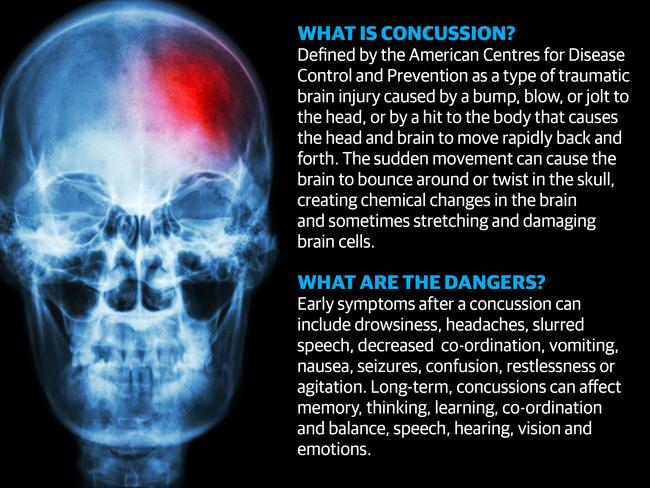
But Larkins said the only way to limit the incidence of concussion — in particular the asymptomatic subconcussive episodes — was to change “the fabric of the game” and make it less of a contact sport.
“We’re known for our physical sport, we are known for our tackling, we are known for bumping — overseas people love to watch the game,” Larkins said.
“Perhaps we have been fooling ourselves, perhaps we need to be making the game less physical. I can’t believe I’m saying that, I love watching footy.
“The spear tackle has been taken out, the sling tackle has been taken out, the sport has put in place rules to protect players. Whether we need to be more conservative, that would make bumping and tackling even more restrictive.
“Maybe that’s the way to go because I am struggling to know how to prevent the subconcussive episodes.
“If you say, ‘Do we need to be more protective as a sport generally’, I’m talking about Aussie rules across the community, then maybe we have got to make it a less contact sport. “That’s a radical thought … but it would make a difference to how much risk there is of head injury.’’
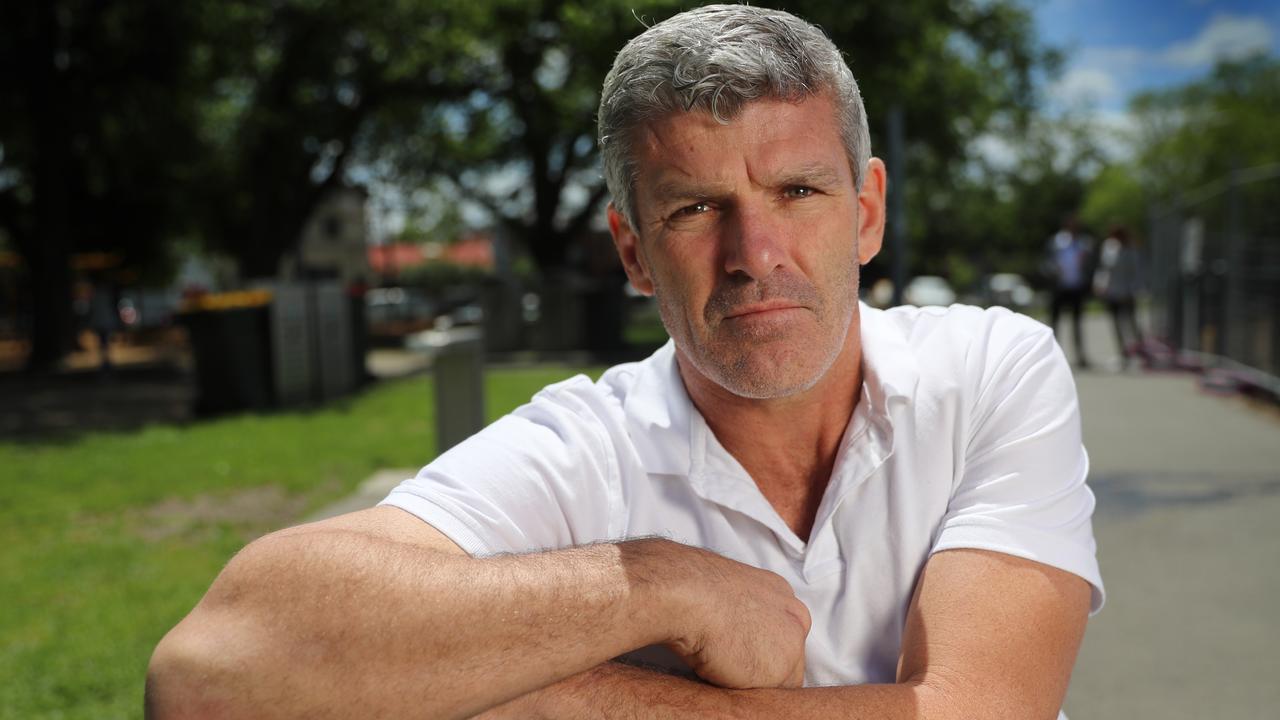
SMITH: MANY MORE SUFFERING LIKE POLLY
—Michael Warner
Mark of the Century high-flyer Shaun Smith says “Polly” Farmer’s CTE diagnosis will be the first of many.
“It wasn’t a case of if, but when,” Smith said yesterday.
“Unfortunately, there’s a thousand more Polly Farmer’s out there.”
Smith, 50, was “knocked out cold” 12-14 times during his 109-game career with Melbourne and North Melbourne on top of dozens of sub-concussive hits.
He believes he is suffering from his own CTE symptoms.
“I saw what Polly’s family said in the paper about him being angry and having mood swings … and I just went tick, tick, tick, tick, tick.
“It was like reading about me. I felt sad for the Farmer family.”

MORE AFL CONCUSSION NEWS:
Graham ‘Polly’ Farmer first Aussie rules player diagnosed with CTE
Try the concussion test taken by AFL players on game day
Mark of the Century hero Shaun Smith reveals crippling toll of repeated concussion during AFL career
It was revealed two weeks ago that Smith had been paid out his superannuation a decade in advance because of the crippling brain injuries he suffered while playing footy.
Fund trustees for Cbus Super agreed to the early release of his benefit on the grounds of “Permanent Incapacity”.
The company accepted independent medical advice declaring him incapable of ever returning to the workforce.
The extent of his head trauma was laid bare in private medical files released by Smith last year.
The gruesome report described numerous lesions and “deep white matter” on his brain and symptoms including depression, pervasive suicidal ideation, feelings of hopelessness, social withdrawal, insomnia, and poor short-term memory.
He survived a suicide attempt last October and has been under regular care in a Melbourne psychiatric clinic.
“It would be worse at the local level,” Smith said of footy’s concussion scourge.
“I don’t even want to think about what happens at the local level.”
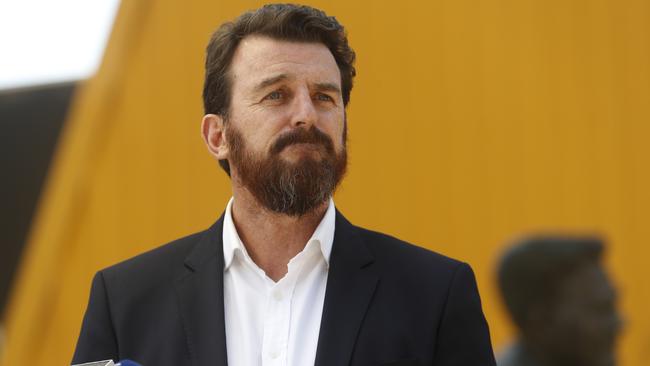
WHY GALE WAS PLEASED TO SEE FORMER TIGER WALK AWAY
—Lauren Wood
The “confronting” issue of concussion is front of mind for two of the game’s top administrators, one of whom concedes that head trauma is the most significant medical issue facing the game.
Richmond chief executive Brendon Gale admits part of him was pleased to see former Tiger Ben Griffiths — who retired from football in 2018 after a career plagued by concussions — step away from the game and said that “we can’t be too vigilant” when it comes to concussion.
He said the “distressing” news that Graham “Polly” Farmer suffered from chronic traumatic encephalopathy had caused him to reflect.
“You pick up the paper and you read that and it forces you to reflect — a lot — as administrators. What are we doing, and is it enough?,” Gale said. “With the information that we know, I would say we are.”
Griffiths — who now serves as a punter at the University of Southern California — did not retire solely due to concussion, but Gale admits it was something of a relief.
“It’s something we think about a lot,” he said. “I was concerned about Ben Griffiths. Part of me was happy when he retired — I was concerned about his welfare.”

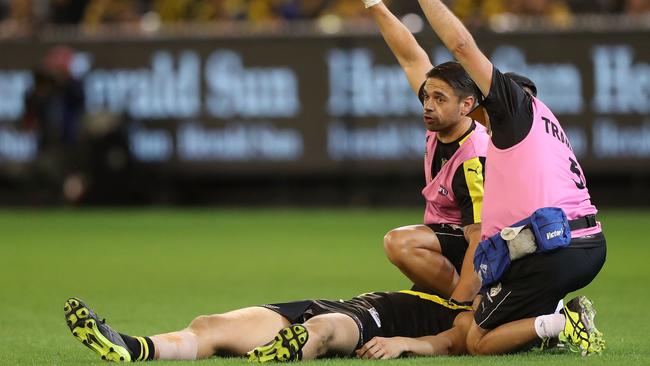
As former chief executive of the AFL Players’ Association, Gale said he had long had an interest in the area.
“Our most important responsibility is to the welfare and safety of our athletes,” he said. “That’s the most important responsibility.
“When you see something like that … I’d never met ‘Polly’, but he’s obviously a legend of the game. It’s very distressing to think about what he endured, particularly in the latter stages of his life.”
Gale, who played 244 games for Richmond before embarking on his career as a lawyer and administrator, said it also prompted him to consider his own circumstances and the “rattles” he suffered as a player. But the current concussion landscape sits well with him.
“As an administrator – a person whose responsibility and duty to our players’ health and safety and welfare is the paramount duty, I’m satisfied with all the steps that have been taken around prevention, about medical management (and) community leadership, as well,” he said.
“There’s a lot of research. I’m a lawyer, I’m not an expert, but with the knowledge that is available by virtue of these surveys and research, I think that our industry has taken the appropriate steps to prevent and mitigate.”
Western Bulldogs CEO Ameet Bains said he had become “acutely aware” of concussion and the effects first-hand on former Bulldogs Liam Picken and Koby Stevens who were both forced to retire due to concussion.
“It (concussion) is the most significant medical issue that clubs pay heed to these days,” Bains said.
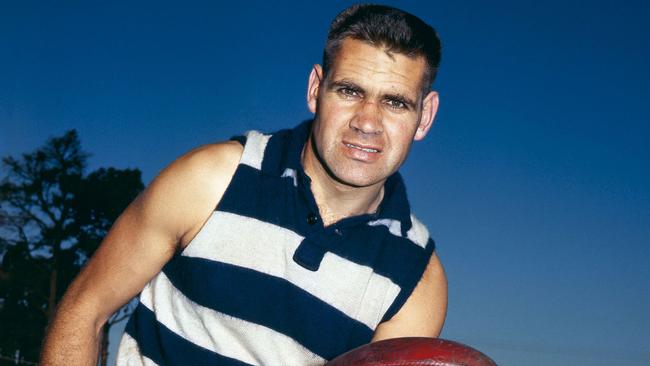
AFL’S RESPONSE TO POLLY BOMBSHELL
—Sam Landsberger and Glenn McFarlane
The AFL has vowed to use the findings from Graham ‘Polly’ Farmer’s brain to drive player safety as sports around the world grapple with advancements in concussion research.
League chief executive Gillon McLachlan thanked the Farmer family for donating the former Geelong legend’s brain to the Australian Sports Brain Bank.
“I want to acknowledge and thank the Farmer family, Polly Farmer, for a significant action in donating his brain,” McLachlan said yesterday.
“The learnings that we’ll get from that, and the medical fraternity will get from that, it’s clearly about prevention, diagnosis and about research. We’ll continue to learn. The health and safety of our players is paramount, and we’ll continue to work with the medical fraternity and the experts in all those three areas to make sure our game is safe at all times.”
West Coast premiership player Daniel Venables, 21, is still struggling with concussion symptoms nine months after a car crash-like collision he suffered on the field. “There’s some players out there that have concussion now and the clubs are doing the right thing by them,” Eagles teammate Elliot Yeo said yesterday.
“(For Venables) to be held back because of a concussion injury, it’s heartbreaking, really, because your body is fine, but your brain isn’t.”
The AFL has not seen a detailed report in relation to Farmer’s diagnosis. But the league said it supported the Brain Bank’s work and welcomed learnings from the ongoing research.
The AFL has strengthened its concussion protocols in 2020 — players will be ruled out of matches five days in advance unless they can prove their health after suffering head knocks. The tighter guidelines saw Western Bulldogs ruckman Tim English miss last week’s Marsh Series game against North Melbourne because he still had a headache on the Monday after being concussed in an intra-club game the previous Wednesday.
Originally published as Former St Kilda defender Matt Maguire reveals the devastating king hit that left him with blood spots on his brain

